INF701: Strategic Frameworks Analysis for Telecommunication Industry
VerifiedAdded on 2023/01/10
|21
|4783
|65
Report
AI Summary
This report provides an in-depth analysis of strategic frameworks within the context of management informatics, focusing on their application within the telecommunications industry, specifically using Telstra as a case study. The report begins with an executive summary, followed by an introduction that defines strategic frameworks and highlights their importance. The core of the report is a discussion of four key strategic frameworks: SWOT analysis, balanced scorecard, Porter’s five forces, and work-centered analysis. Each framework is explained, detailing its purpose and components. The report then explores the background of Telstra, detailing its evolution and market position. It assesses the efficiency and effectiveness of SWOT analysis and Porter’s five forces within Telstra, providing real-world examples of their implementation. The report concludes with recommendations for Telstra based on the analyses and a comprehensive conclusion summarizing the key findings and their implications. The report includes references and an appendix with supplementary information.
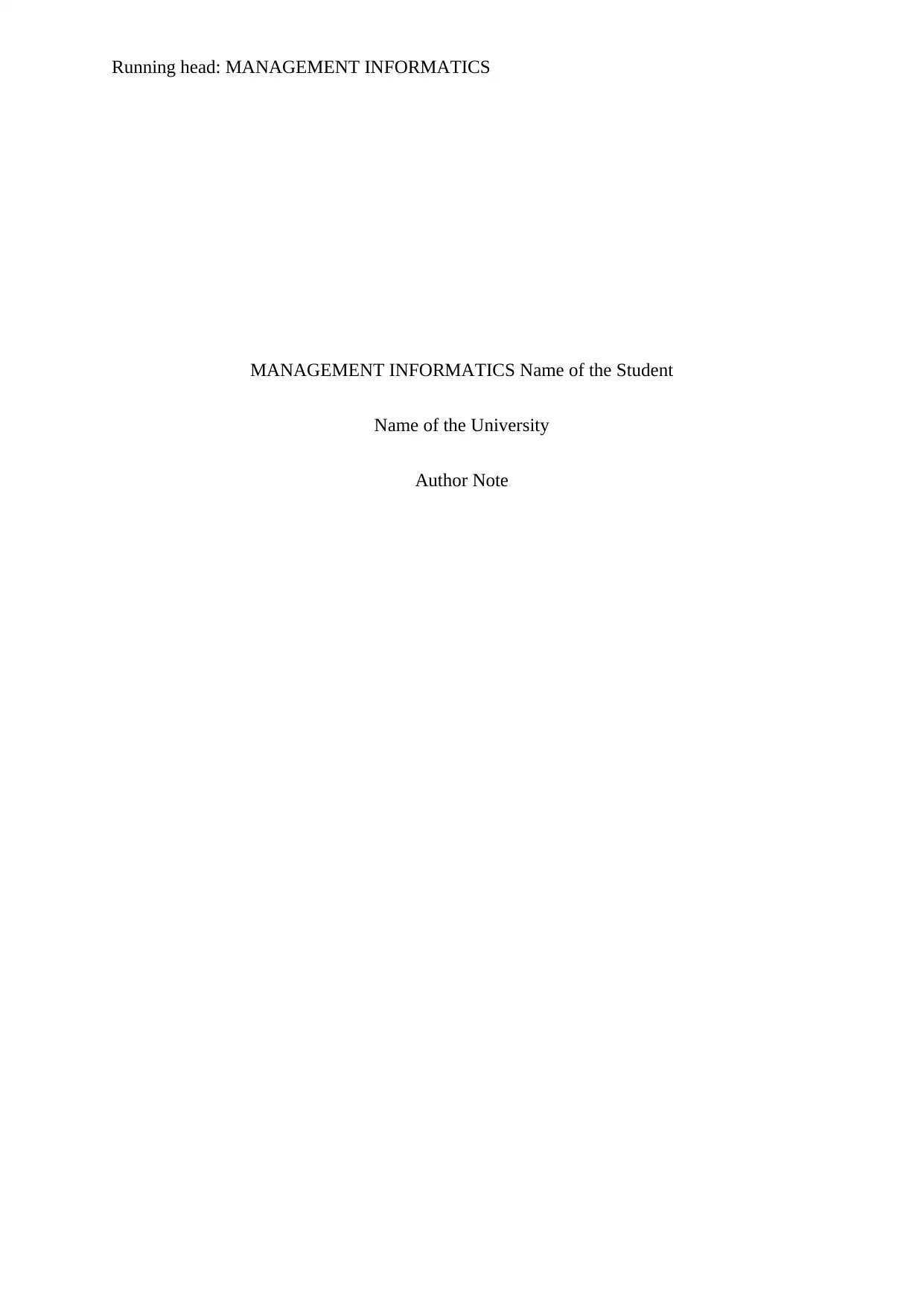
Running head: MANAGEMENT INFORMATICS
MANAGEMENT INFORMATICS Name of the Student
Name of the University
Author Note
MANAGEMENT INFORMATICS Name of the Student
Name of the University
Author Note
Paraphrase This Document
Need a fresh take? Get an instant paraphrase of this document with our AI Paraphraser
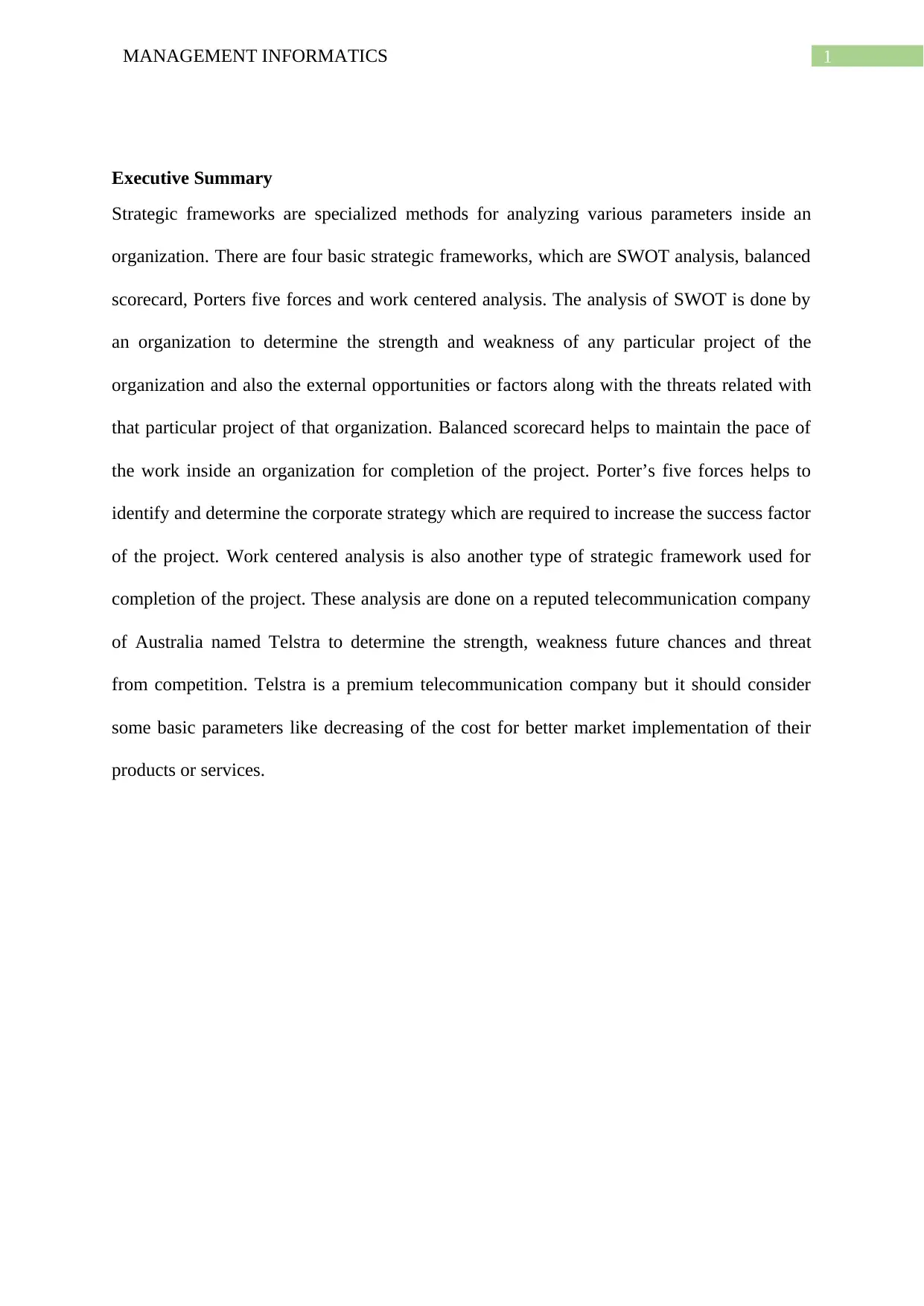
1MANAGEMENT INFORMATICS
Executive Summary
Strategic frameworks are specialized methods for analyzing various parameters inside an
organization. There are four basic strategic frameworks, which are SWOT analysis, balanced
scorecard, Porters five forces and work centered analysis. The analysis of SWOT is done by
an organization to determine the strength and weakness of any particular project of the
organization and also the external opportunities or factors along with the threats related with
that particular project of that organization. Balanced scorecard helps to maintain the pace of
the work inside an organization for completion of the project. Porter’s five forces helps to
identify and determine the corporate strategy which are required to increase the success factor
of the project. Work centered analysis is also another type of strategic framework used for
completion of the project. These analysis are done on a reputed telecommunication company
of Australia named Telstra to determine the strength, weakness future chances and threat
from competition. Telstra is a premium telecommunication company but it should consider
some basic parameters like decreasing of the cost for better market implementation of their
products or services.
Executive Summary
Strategic frameworks are specialized methods for analyzing various parameters inside an
organization. There are four basic strategic frameworks, which are SWOT analysis, balanced
scorecard, Porters five forces and work centered analysis. The analysis of SWOT is done by
an organization to determine the strength and weakness of any particular project of the
organization and also the external opportunities or factors along with the threats related with
that particular project of that organization. Balanced scorecard helps to maintain the pace of
the work inside an organization for completion of the project. Porter’s five forces helps to
identify and determine the corporate strategy which are required to increase the success factor
of the project. Work centered analysis is also another type of strategic framework used for
completion of the project. These analysis are done on a reputed telecommunication company
of Australia named Telstra to determine the strength, weakness future chances and threat
from competition. Telstra is a premium telecommunication company but it should consider
some basic parameters like decreasing of the cost for better market implementation of their
products or services.

2MANAGEMENT INFORMATICS
Table of Contents
List of Abbreviations..................................................................................................................3
1. Introduction............................................................................................................................4
2. Discussion..............................................................................................................................5
2.1. Background of the organization......................................................................................5
2.2. Discussion of four matrices.............................................................................................6
2.2.1. SWOT analysis.........................................................................................................6
2.2.2Balanced scorecard.....................................................................................................7
2.2.3. Porter’s five forces...................................................................................................8
2.2.4. Work centered analysis..........................................................................................10
2.3. Assessment of efficiency and effectiveness of two matrices in Telstra........................10
2.3.1. Implementation of SWOT analysis in Telstra........................................................10
2.3.2. Implementation of Porter’s five forces in Telstra..................................................11
3. Recommendations................................................................................................................13
4. Conclusion............................................................................................................................14
5. References............................................................................................................................16
6.Appendix...............................................................................................................................17
References................................................................................................................................18
Table of Contents
List of Abbreviations..................................................................................................................3
1. Introduction............................................................................................................................4
2. Discussion..............................................................................................................................5
2.1. Background of the organization......................................................................................5
2.2. Discussion of four matrices.............................................................................................6
2.2.1. SWOT analysis.........................................................................................................6
2.2.2Balanced scorecard.....................................................................................................7
2.2.3. Porter’s five forces...................................................................................................8
2.2.4. Work centered analysis..........................................................................................10
2.3. Assessment of efficiency and effectiveness of two matrices in Telstra........................10
2.3.1. Implementation of SWOT analysis in Telstra........................................................10
2.3.2. Implementation of Porter’s five forces in Telstra..................................................11
3. Recommendations................................................................................................................13
4. Conclusion............................................................................................................................14
5. References............................................................................................................................16
6.Appendix...............................................................................................................................17
References................................................................................................................................18
⊘ This is a preview!⊘
Do you want full access?
Subscribe today to unlock all pages.

Trusted by 1+ million students worldwide
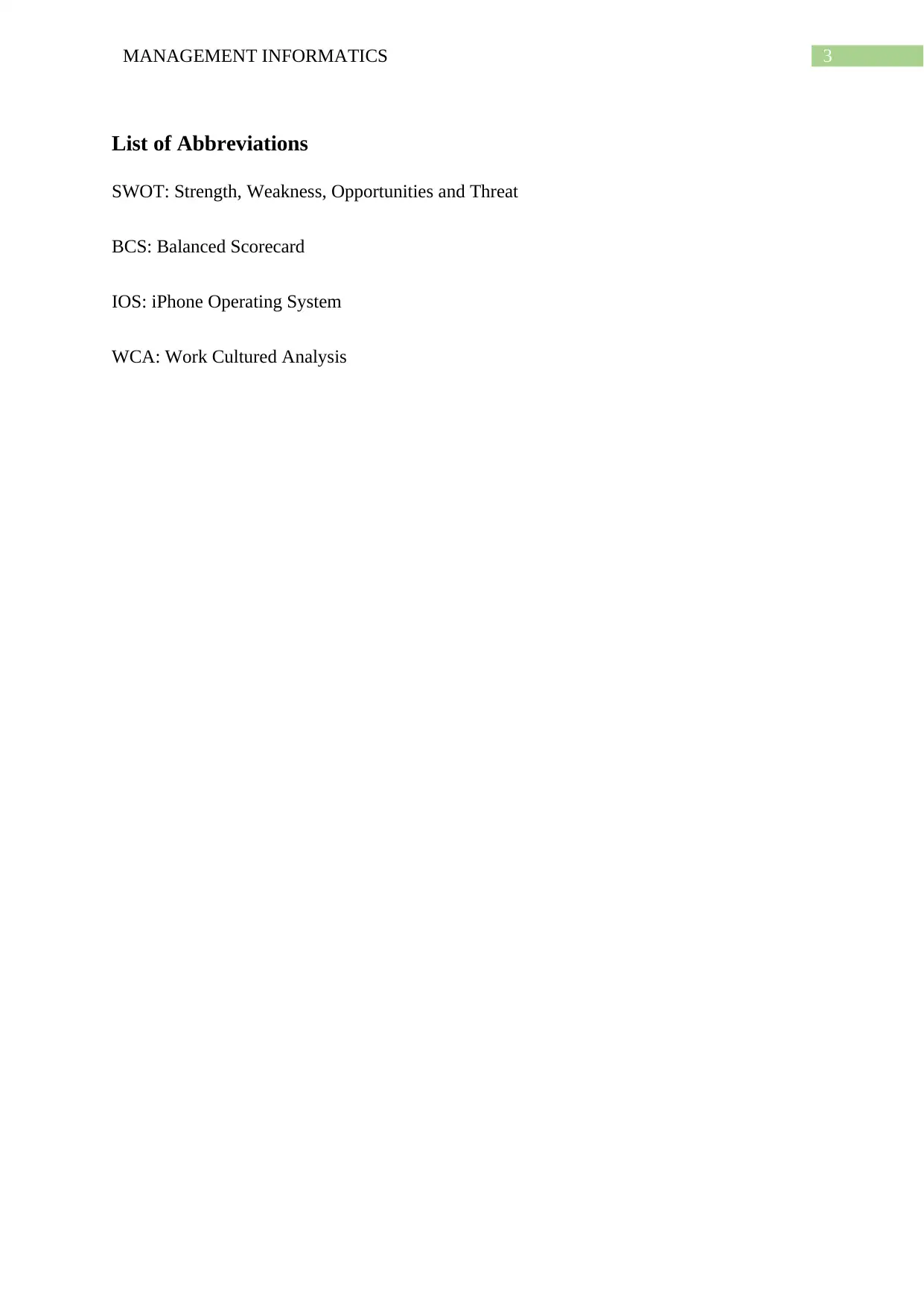
3MANAGEMENT INFORMATICS
List of Abbreviations
SWOT: Strength, Weakness, Opportunities and Threat
BCS: Balanced Scorecard
IOS: iPhone Operating System
WCA: Work Cultured Analysis
List of Abbreviations
SWOT: Strength, Weakness, Opportunities and Threat
BCS: Balanced Scorecard
IOS: iPhone Operating System
WCA: Work Cultured Analysis
Paraphrase This Document
Need a fresh take? Get an instant paraphrase of this document with our AI Paraphraser
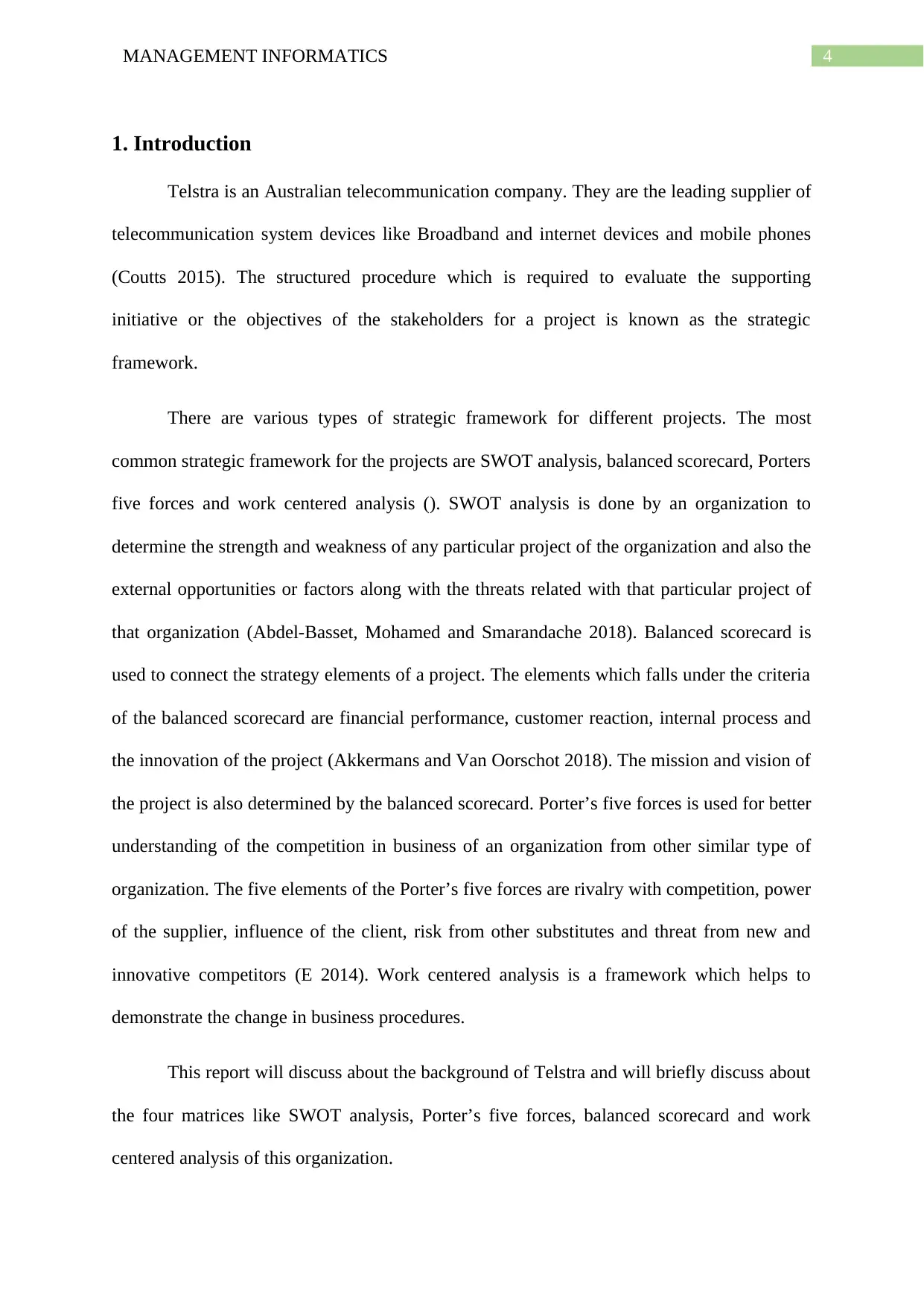
4MANAGEMENT INFORMATICS
1. Introduction
Telstra is an Australian telecommunication company. They are the leading supplier of
telecommunication system devices like Broadband and internet devices and mobile phones
(Coutts 2015). The structured procedure which is required to evaluate the supporting
initiative or the objectives of the stakeholders for a project is known as the strategic
framework.
There are various types of strategic framework for different projects. The most
common strategic framework for the projects are SWOT analysis, balanced scorecard, Porters
five forces and work centered analysis (). SWOT analysis is done by an organization to
determine the strength and weakness of any particular project of the organization and also the
external opportunities or factors along with the threats related with that particular project of
that organization (Abdel-Basset, Mohamed and Smarandache 2018). Balanced scorecard is
used to connect the strategy elements of a project. The elements which falls under the criteria
of the balanced scorecard are financial performance, customer reaction, internal process and
the innovation of the project (Akkermans and Van Oorschot 2018). The mission and vision of
the project is also determined by the balanced scorecard. Porter’s five forces is used for better
understanding of the competition in business of an organization from other similar type of
organization. The five elements of the Porter’s five forces are rivalry with competition, power
of the supplier, influence of the client, risk from other substitutes and threat from new and
innovative competitors (E 2014). Work centered analysis is a framework which helps to
demonstrate the change in business procedures.
This report will discuss about the background of Telstra and will briefly discuss about
the four matrices like SWOT analysis, Porter’s five forces, balanced scorecard and work
centered analysis of this organization.
1. Introduction
Telstra is an Australian telecommunication company. They are the leading supplier of
telecommunication system devices like Broadband and internet devices and mobile phones
(Coutts 2015). The structured procedure which is required to evaluate the supporting
initiative or the objectives of the stakeholders for a project is known as the strategic
framework.
There are various types of strategic framework for different projects. The most
common strategic framework for the projects are SWOT analysis, balanced scorecard, Porters
five forces and work centered analysis (). SWOT analysis is done by an organization to
determine the strength and weakness of any particular project of the organization and also the
external opportunities or factors along with the threats related with that particular project of
that organization (Abdel-Basset, Mohamed and Smarandache 2018). Balanced scorecard is
used to connect the strategy elements of a project. The elements which falls under the criteria
of the balanced scorecard are financial performance, customer reaction, internal process and
the innovation of the project (Akkermans and Van Oorschot 2018). The mission and vision of
the project is also determined by the balanced scorecard. Porter’s five forces is used for better
understanding of the competition in business of an organization from other similar type of
organization. The five elements of the Porter’s five forces are rivalry with competition, power
of the supplier, influence of the client, risk from other substitutes and threat from new and
innovative competitors (E 2014). Work centered analysis is a framework which helps to
demonstrate the change in business procedures.
This report will discuss about the background of Telstra and will briefly discuss about
the four matrices like SWOT analysis, Porter’s five forces, balanced scorecard and work
centered analysis of this organization.
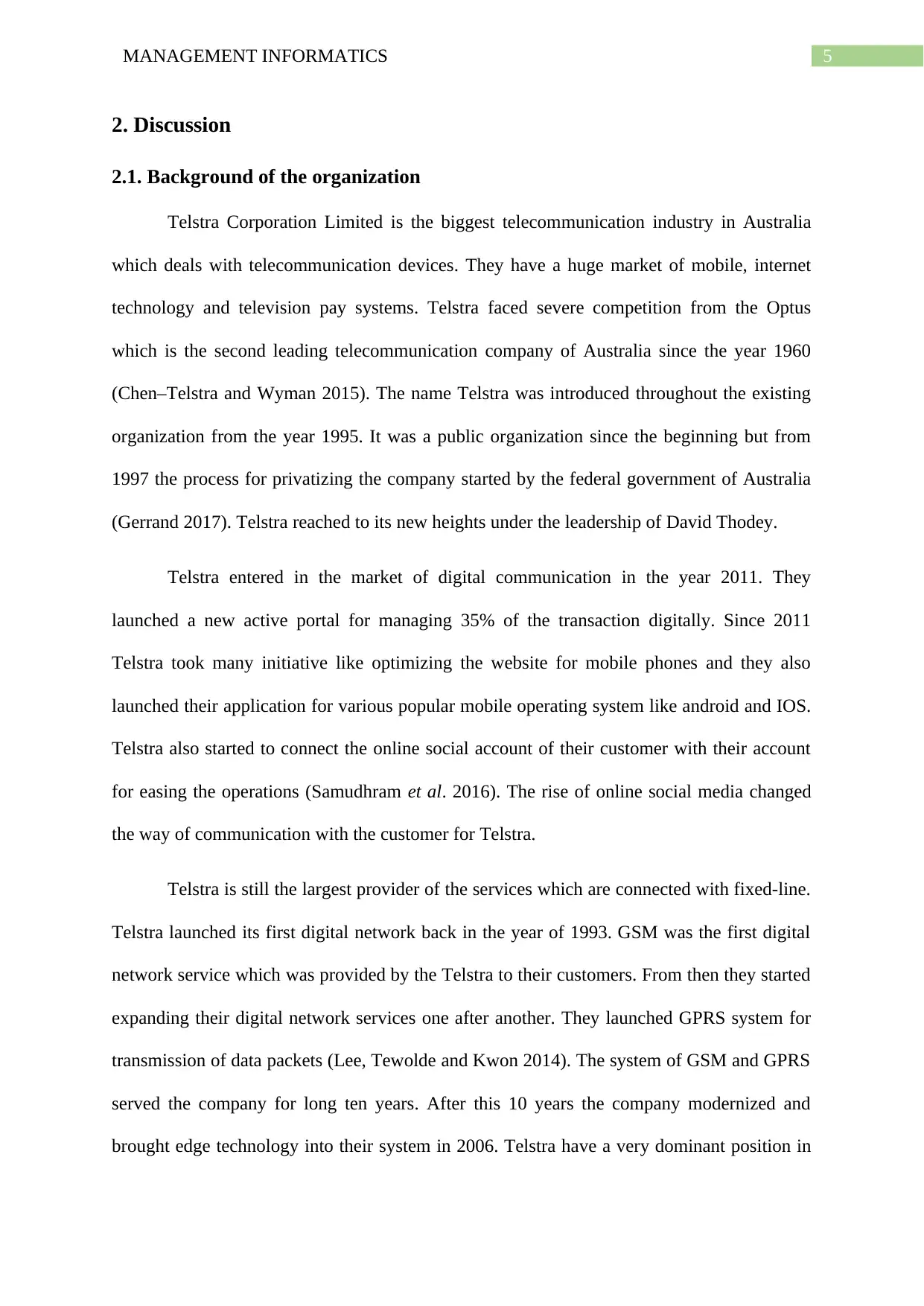
5MANAGEMENT INFORMATICS
2. Discussion
2.1. Background of the organization
Telstra Corporation Limited is the biggest telecommunication industry in Australia
which deals with telecommunication devices. They have a huge market of mobile, internet
technology and television pay systems. Telstra faced severe competition from the Optus
which is the second leading telecommunication company of Australia since the year 1960
(Chen–Telstra and Wyman 2015). The name Telstra was introduced throughout the existing
organization from the year 1995. It was a public organization since the beginning but from
1997 the process for privatizing the company started by the federal government of Australia
(Gerrand 2017). Telstra reached to its new heights under the leadership of David Thodey.
Telstra entered in the market of digital communication in the year 2011. They
launched a new active portal for managing 35% of the transaction digitally. Since 2011
Telstra took many initiative like optimizing the website for mobile phones and they also
launched their application for various popular mobile operating system like android and IOS.
Telstra also started to connect the online social account of their customer with their account
for easing the operations (Samudhram et al. 2016). The rise of online social media changed
the way of communication with the customer for Telstra.
Telstra is still the largest provider of the services which are connected with fixed-line.
Telstra launched its first digital network back in the year of 1993. GSM was the first digital
network service which was provided by the Telstra to their customers. From then they started
expanding their digital network services one after another. They launched GPRS system for
transmission of data packets (Lee, Tewolde and Kwon 2014). The system of GSM and GPRS
served the company for long ten years. After this 10 years the company modernized and
brought edge technology into their system in 2006. Telstra have a very dominant position in
2. Discussion
2.1. Background of the organization
Telstra Corporation Limited is the biggest telecommunication industry in Australia
which deals with telecommunication devices. They have a huge market of mobile, internet
technology and television pay systems. Telstra faced severe competition from the Optus
which is the second leading telecommunication company of Australia since the year 1960
(Chen–Telstra and Wyman 2015). The name Telstra was introduced throughout the existing
organization from the year 1995. It was a public organization since the beginning but from
1997 the process for privatizing the company started by the federal government of Australia
(Gerrand 2017). Telstra reached to its new heights under the leadership of David Thodey.
Telstra entered in the market of digital communication in the year 2011. They
launched a new active portal for managing 35% of the transaction digitally. Since 2011
Telstra took many initiative like optimizing the website for mobile phones and they also
launched their application for various popular mobile operating system like android and IOS.
Telstra also started to connect the online social account of their customer with their account
for easing the operations (Samudhram et al. 2016). The rise of online social media changed
the way of communication with the customer for Telstra.
Telstra is still the largest provider of the services which are connected with fixed-line.
Telstra launched its first digital network back in the year of 1993. GSM was the first digital
network service which was provided by the Telstra to their customers. From then they started
expanding their digital network services one after another. They launched GPRS system for
transmission of data packets (Lee, Tewolde and Kwon 2014). The system of GSM and GPRS
served the company for long ten years. After this 10 years the company modernized and
brought edge technology into their system in 2006. Telstra have a very dominant position in
⊘ This is a preview!⊘
Do you want full access?
Subscribe today to unlock all pages.

Trusted by 1+ million students worldwide
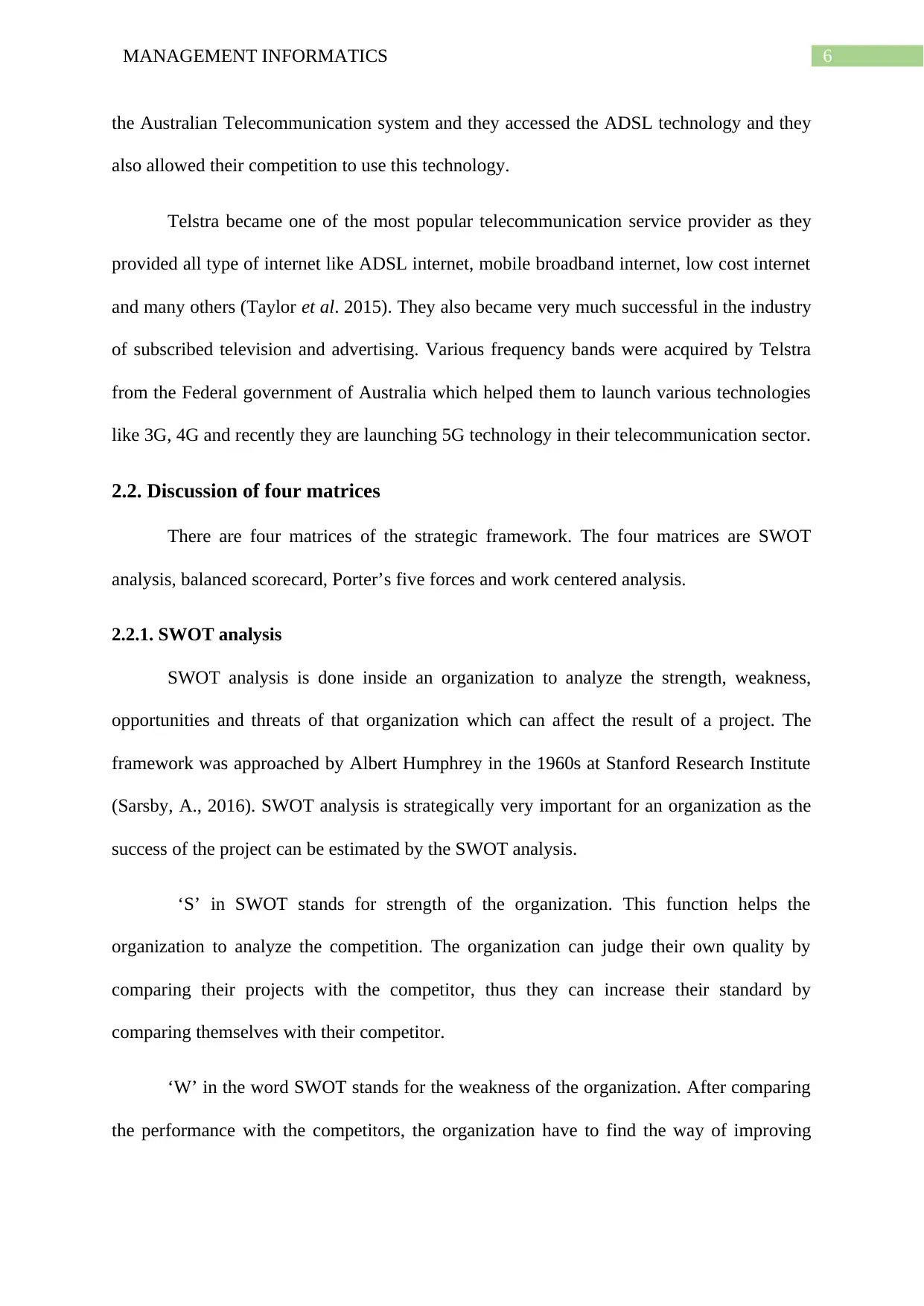
6MANAGEMENT INFORMATICS
the Australian Telecommunication system and they accessed the ADSL technology and they
also allowed their competition to use this technology.
Telstra became one of the most popular telecommunication service provider as they
provided all type of internet like ADSL internet, mobile broadband internet, low cost internet
and many others (Taylor et al. 2015). They also became very much successful in the industry
of subscribed television and advertising. Various frequency bands were acquired by Telstra
from the Federal government of Australia which helped them to launch various technologies
like 3G, 4G and recently they are launching 5G technology in their telecommunication sector.
2.2. Discussion of four matrices
There are four matrices of the strategic framework. The four matrices are SWOT
analysis, balanced scorecard, Porter’s five forces and work centered analysis.
2.2.1. SWOT analysis
SWOT analysis is done inside an organization to analyze the strength, weakness,
opportunities and threats of that organization which can affect the result of a project. The
framework was approached by Albert Humphrey in the 1960s at Stanford Research Institute
(Sarsby, A., 2016). SWOT analysis is strategically very important for an organization as the
success of the project can be estimated by the SWOT analysis.
‘S’ in SWOT stands for strength of the organization. This function helps the
organization to analyze the competition. The organization can judge their own quality by
comparing their projects with the competitor, thus they can increase their standard by
comparing themselves with their competitor.
‘W’ in the word SWOT stands for the weakness of the organization. After comparing
the performance with the competitors, the organization have to find the way of improving
the Australian Telecommunication system and they accessed the ADSL technology and they
also allowed their competition to use this technology.
Telstra became one of the most popular telecommunication service provider as they
provided all type of internet like ADSL internet, mobile broadband internet, low cost internet
and many others (Taylor et al. 2015). They also became very much successful in the industry
of subscribed television and advertising. Various frequency bands were acquired by Telstra
from the Federal government of Australia which helped them to launch various technologies
like 3G, 4G and recently they are launching 5G technology in their telecommunication sector.
2.2. Discussion of four matrices
There are four matrices of the strategic framework. The four matrices are SWOT
analysis, balanced scorecard, Porter’s five forces and work centered analysis.
2.2.1. SWOT analysis
SWOT analysis is done inside an organization to analyze the strength, weakness,
opportunities and threats of that organization which can affect the result of a project. The
framework was approached by Albert Humphrey in the 1960s at Stanford Research Institute
(Sarsby, A., 2016). SWOT analysis is strategically very important for an organization as the
success of the project can be estimated by the SWOT analysis.
‘S’ in SWOT stands for strength of the organization. This function helps the
organization to analyze the competition. The organization can judge their own quality by
comparing their projects with the competitor, thus they can increase their standard by
comparing themselves with their competitor.
‘W’ in the word SWOT stands for the weakness of the organization. After comparing
the performance with the competitors, the organization have to find the way of improving
Paraphrase This Document
Need a fresh take? Get an instant paraphrase of this document with our AI Paraphraser
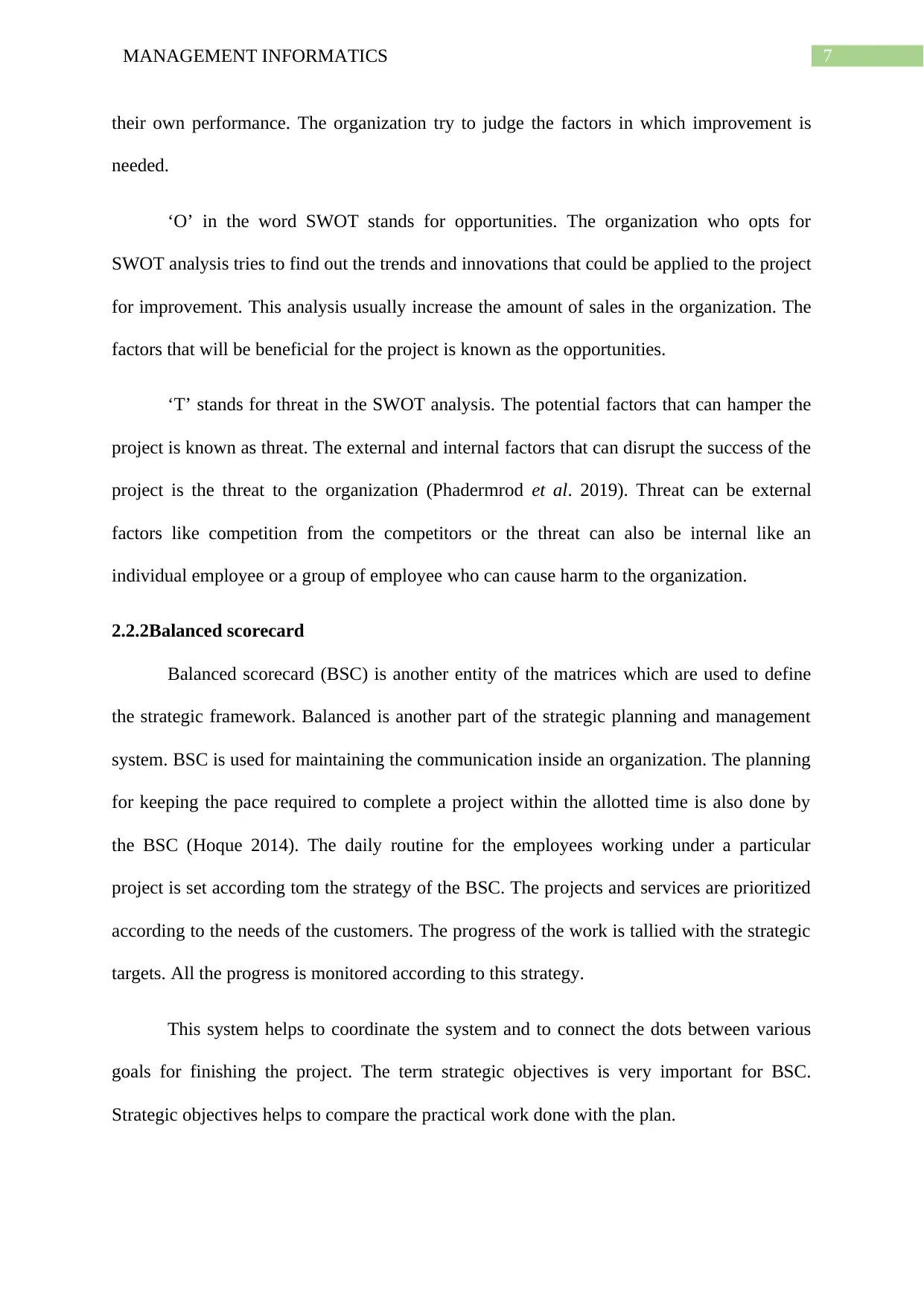
7MANAGEMENT INFORMATICS
their own performance. The organization try to judge the factors in which improvement is
needed.
‘O’ in the word SWOT stands for opportunities. The organization who opts for
SWOT analysis tries to find out the trends and innovations that could be applied to the project
for improvement. This analysis usually increase the amount of sales in the organization. The
factors that will be beneficial for the project is known as the opportunities.
‘T’ stands for threat in the SWOT analysis. The potential factors that can hamper the
project is known as threat. The external and internal factors that can disrupt the success of the
project is the threat to the organization (Phadermrod et al. 2019). Threat can be external
factors like competition from the competitors or the threat can also be internal like an
individual employee or a group of employee who can cause harm to the organization.
2.2.2Balanced scorecard
Balanced scorecard (BSC) is another entity of the matrices which are used to define
the strategic framework. Balanced is another part of the strategic planning and management
system. BSC is used for maintaining the communication inside an organization. The planning
for keeping the pace required to complete a project within the allotted time is also done by
the BSC (Hoque 2014). The daily routine for the employees working under a particular
project is set according tom the strategy of the BSC. The projects and services are prioritized
according to the needs of the customers. The progress of the work is tallied with the strategic
targets. All the progress is monitored according to this strategy.
This system helps to coordinate the system and to connect the dots between various
goals for finishing the project. The term strategic objectives is very important for BSC.
Strategic objectives helps to compare the practical work done with the plan.
their own performance. The organization try to judge the factors in which improvement is
needed.
‘O’ in the word SWOT stands for opportunities. The organization who opts for
SWOT analysis tries to find out the trends and innovations that could be applied to the project
for improvement. This analysis usually increase the amount of sales in the organization. The
factors that will be beneficial for the project is known as the opportunities.
‘T’ stands for threat in the SWOT analysis. The potential factors that can hamper the
project is known as threat. The external and internal factors that can disrupt the success of the
project is the threat to the organization (Phadermrod et al. 2019). Threat can be external
factors like competition from the competitors or the threat can also be internal like an
individual employee or a group of employee who can cause harm to the organization.
2.2.2Balanced scorecard
Balanced scorecard (BSC) is another entity of the matrices which are used to define
the strategic framework. Balanced is another part of the strategic planning and management
system. BSC is used for maintaining the communication inside an organization. The planning
for keeping the pace required to complete a project within the allotted time is also done by
the BSC (Hoque 2014). The daily routine for the employees working under a particular
project is set according tom the strategy of the BSC. The projects and services are prioritized
according to the needs of the customers. The progress of the work is tallied with the strategic
targets. All the progress is monitored according to this strategy.
This system helps to coordinate the system and to connect the dots between various
goals for finishing the project. The term strategic objectives is very important for BSC.
Strategic objectives helps to compare the practical work done with the plan.
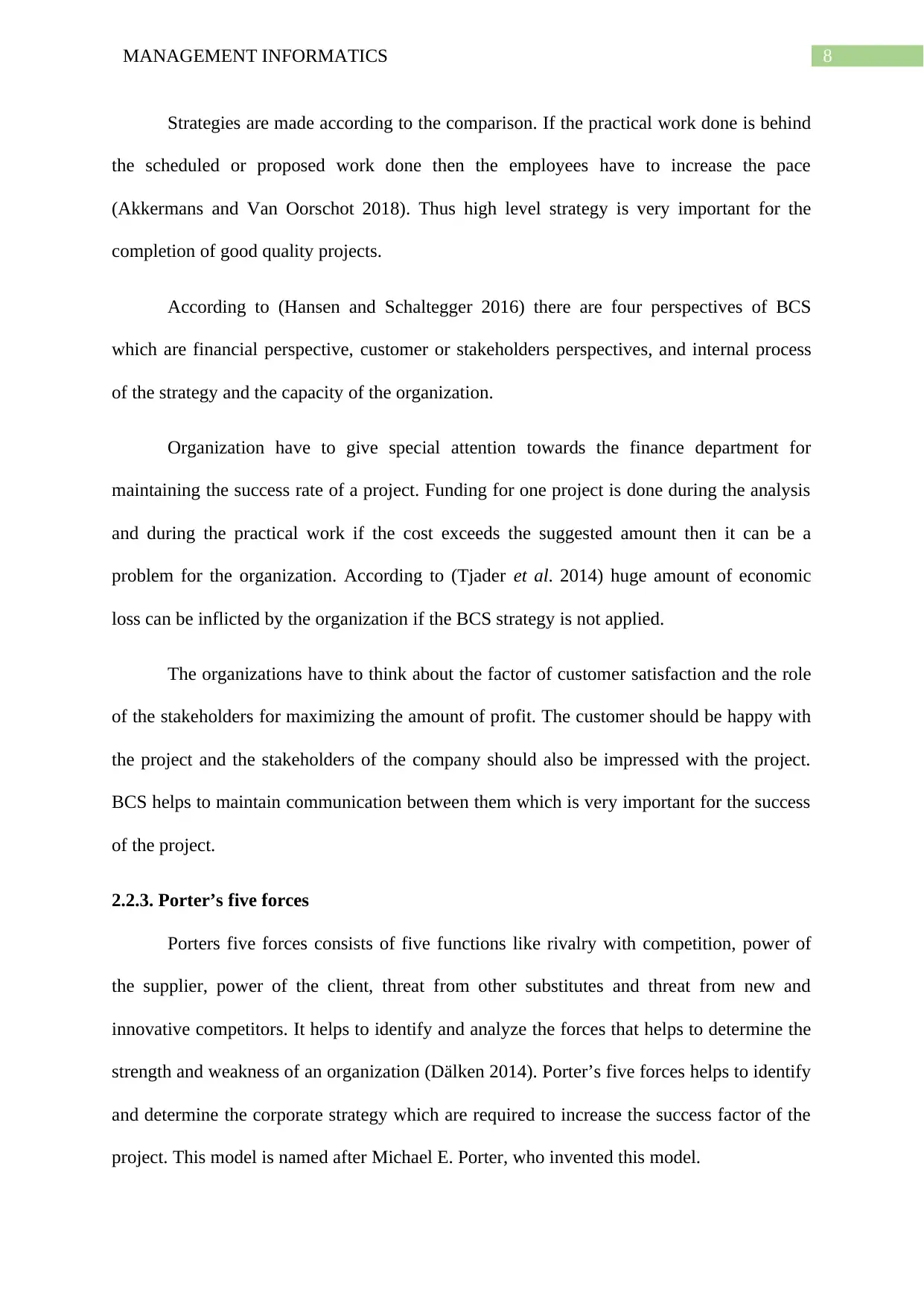
8MANAGEMENT INFORMATICS
Strategies are made according to the comparison. If the practical work done is behind
the scheduled or proposed work done then the employees have to increase the pace
(Akkermans and Van Oorschot 2018). Thus high level strategy is very important for the
completion of good quality projects.
According to (Hansen and Schaltegger 2016) there are four perspectives of BCS
which are financial perspective, customer or stakeholders perspectives, and internal process
of the strategy and the capacity of the organization.
Organization have to give special attention towards the finance department for
maintaining the success rate of a project. Funding for one project is done during the analysis
and during the practical work if the cost exceeds the suggested amount then it can be a
problem for the organization. According to (Tjader et al. 2014) huge amount of economic
loss can be inflicted by the organization if the BCS strategy is not applied.
The organizations have to think about the factor of customer satisfaction and the role
of the stakeholders for maximizing the amount of profit. The customer should be happy with
the project and the stakeholders of the company should also be impressed with the project.
BCS helps to maintain communication between them which is very important for the success
of the project.
2.2.3. Porter’s five forces
Porters five forces consists of five functions like rivalry with competition, power of
the supplier, power of the client, threat from other substitutes and threat from new and
innovative competitors. It helps to identify and analyze the forces that helps to determine the
strength and weakness of an organization (Dälken 2014). Porter’s five forces helps to identify
and determine the corporate strategy which are required to increase the success factor of the
project. This model is named after Michael E. Porter, who invented this model.
Strategies are made according to the comparison. If the practical work done is behind
the scheduled or proposed work done then the employees have to increase the pace
(Akkermans and Van Oorschot 2018). Thus high level strategy is very important for the
completion of good quality projects.
According to (Hansen and Schaltegger 2016) there are four perspectives of BCS
which are financial perspective, customer or stakeholders perspectives, and internal process
of the strategy and the capacity of the organization.
Organization have to give special attention towards the finance department for
maintaining the success rate of a project. Funding for one project is done during the analysis
and during the practical work if the cost exceeds the suggested amount then it can be a
problem for the organization. According to (Tjader et al. 2014) huge amount of economic
loss can be inflicted by the organization if the BCS strategy is not applied.
The organizations have to think about the factor of customer satisfaction and the role
of the stakeholders for maximizing the amount of profit. The customer should be happy with
the project and the stakeholders of the company should also be impressed with the project.
BCS helps to maintain communication between them which is very important for the success
of the project.
2.2.3. Porter’s five forces
Porters five forces consists of five functions like rivalry with competition, power of
the supplier, power of the client, threat from other substitutes and threat from new and
innovative competitors. It helps to identify and analyze the forces that helps to determine the
strength and weakness of an organization (Dälken 2014). Porter’s five forces helps to identify
and determine the corporate strategy which are required to increase the success factor of the
project. This model is named after Michael E. Porter, who invented this model.
⊘ This is a preview!⊘
Do you want full access?
Subscribe today to unlock all pages.

Trusted by 1+ million students worldwide
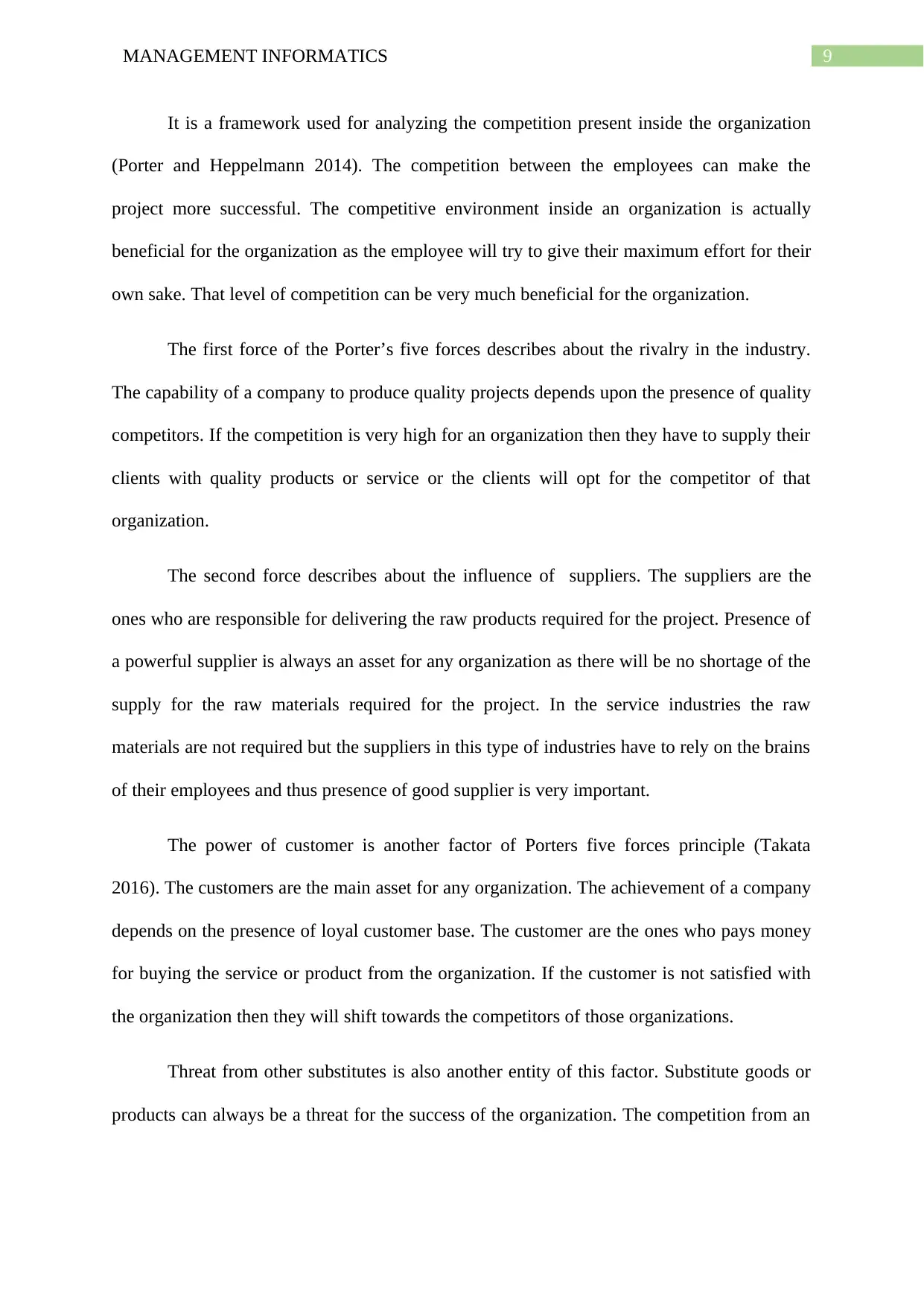
9MANAGEMENT INFORMATICS
It is a framework used for analyzing the competition present inside the organization
(Porter and Heppelmann 2014). The competition between the employees can make the
project more successful. The competitive environment inside an organization is actually
beneficial for the organization as the employee will try to give their maximum effort for their
own sake. That level of competition can be very much beneficial for the organization.
The first force of the Porter’s five forces describes about the rivalry in the industry.
The capability of a company to produce quality projects depends upon the presence of quality
competitors. If the competition is very high for an organization then they have to supply their
clients with quality products or service or the clients will opt for the competitor of that
organization.
The second force describes about the influence of suppliers. The suppliers are the
ones who are responsible for delivering the raw products required for the project. Presence of
a powerful supplier is always an asset for any organization as there will be no shortage of the
supply for the raw materials required for the project. In the service industries the raw
materials are not required but the suppliers in this type of industries have to rely on the brains
of their employees and thus presence of good supplier is very important.
The power of customer is another factor of Porters five forces principle (Takata
2016). The customers are the main asset for any organization. The achievement of a company
depends on the presence of loyal customer base. The customer are the ones who pays money
for buying the service or product from the organization. If the customer is not satisfied with
the organization then they will shift towards the competitors of those organizations.
Threat from other substitutes is also another entity of this factor. Substitute goods or
products can always be a threat for the success of the organization. The competition from an
It is a framework used for analyzing the competition present inside the organization
(Porter and Heppelmann 2014). The competition between the employees can make the
project more successful. The competitive environment inside an organization is actually
beneficial for the organization as the employee will try to give their maximum effort for their
own sake. That level of competition can be very much beneficial for the organization.
The first force of the Porter’s five forces describes about the rivalry in the industry.
The capability of a company to produce quality projects depends upon the presence of quality
competitors. If the competition is very high for an organization then they have to supply their
clients with quality products or service or the clients will opt for the competitor of that
organization.
The second force describes about the influence of suppliers. The suppliers are the
ones who are responsible for delivering the raw products required for the project. Presence of
a powerful supplier is always an asset for any organization as there will be no shortage of the
supply for the raw materials required for the project. In the service industries the raw
materials are not required but the suppliers in this type of industries have to rely on the brains
of their employees and thus presence of good supplier is very important.
The power of customer is another factor of Porters five forces principle (Takata
2016). The customers are the main asset for any organization. The achievement of a company
depends on the presence of loyal customer base. The customer are the ones who pays money
for buying the service or product from the organization. If the customer is not satisfied with
the organization then they will shift towards the competitors of those organizations.
Threat from other substitutes is also another entity of this factor. Substitute goods or
products can always be a threat for the success of the organization. The competition from an
Paraphrase This Document
Need a fresh take? Get an instant paraphrase of this document with our AI Paraphraser
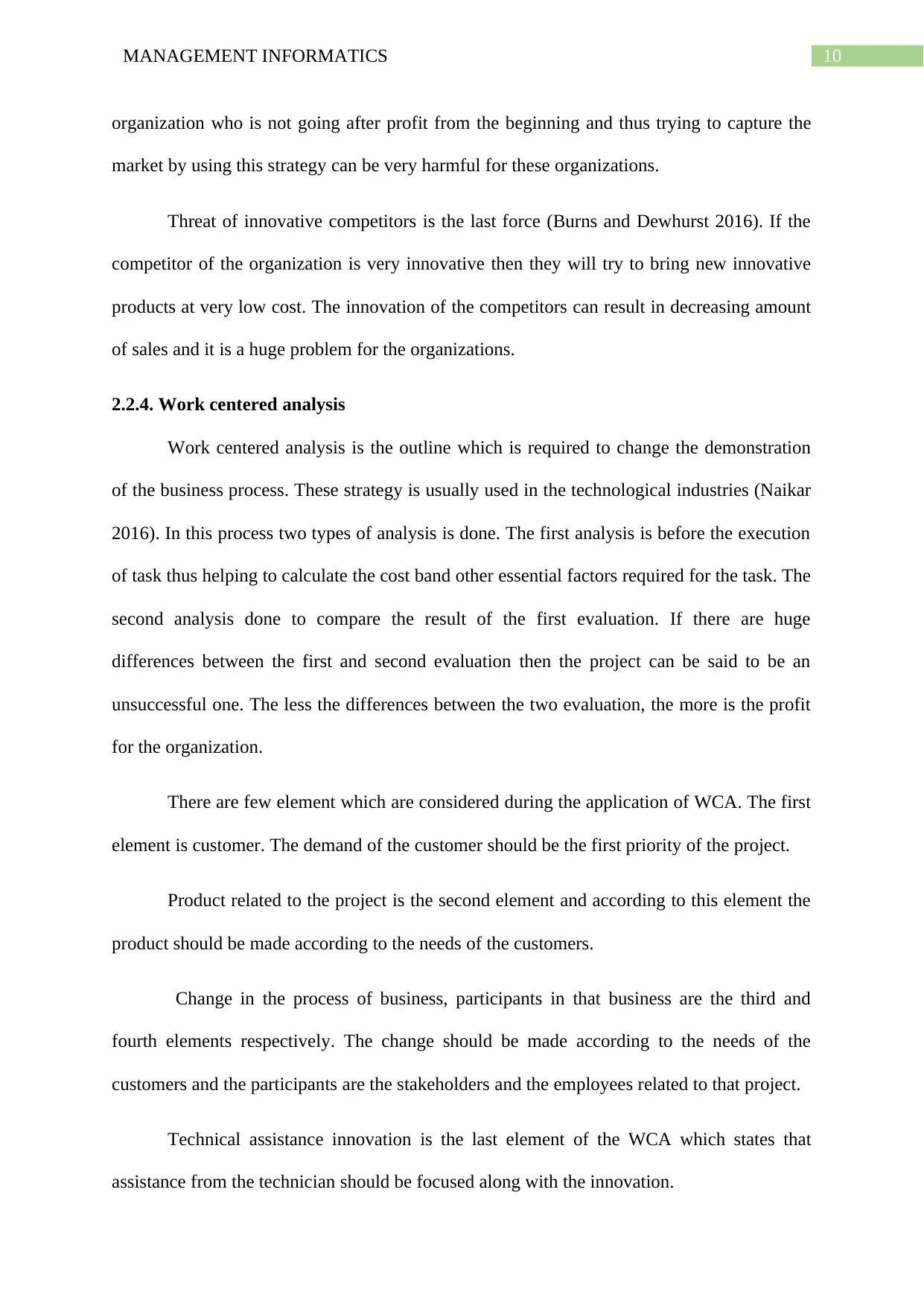
10MANAGEMENT INFORMATICS
organization who is not going after profit from the beginning and thus trying to capture the
market by using this strategy can be very harmful for these organizations.
Threat of innovative competitors is the last force (Burns and Dewhurst 2016). If the
competitor of the organization is very innovative then they will try to bring new innovative
products at very low cost. The innovation of the competitors can result in decreasing amount
of sales and it is a huge problem for the organizations.
2.2.4. Work centered analysis
Work centered analysis is the outline which is required to change the demonstration
of the business process. These strategy is usually used in the technological industries (Naikar
2016). In this process two types of analysis is done. The first analysis is before the execution
of task thus helping to calculate the cost band other essential factors required for the task. The
second analysis done to compare the result of the first evaluation. If there are huge
differences between the first and second evaluation then the project can be said to be an
unsuccessful one. The less the differences between the two evaluation, the more is the profit
for the organization.
There are few element which are considered during the application of WCA. The first
element is customer. The demand of the customer should be the first priority of the project.
Product related to the project is the second element and according to this element the
product should be made according to the needs of the customers.
Change in the process of business, participants in that business are the third and
fourth elements respectively. The change should be made according to the needs of the
customers and the participants are the stakeholders and the employees related to that project.
Technical assistance innovation is the last element of the WCA which states that
assistance from the technician should be focused along with the innovation.
organization who is not going after profit from the beginning and thus trying to capture the
market by using this strategy can be very harmful for these organizations.
Threat of innovative competitors is the last force (Burns and Dewhurst 2016). If the
competitor of the organization is very innovative then they will try to bring new innovative
products at very low cost. The innovation of the competitors can result in decreasing amount
of sales and it is a huge problem for the organizations.
2.2.4. Work centered analysis
Work centered analysis is the outline which is required to change the demonstration
of the business process. These strategy is usually used in the technological industries (Naikar
2016). In this process two types of analysis is done. The first analysis is before the execution
of task thus helping to calculate the cost band other essential factors required for the task. The
second analysis done to compare the result of the first evaluation. If there are huge
differences between the first and second evaluation then the project can be said to be an
unsuccessful one. The less the differences between the two evaluation, the more is the profit
for the organization.
There are few element which are considered during the application of WCA. The first
element is customer. The demand of the customer should be the first priority of the project.
Product related to the project is the second element and according to this element the
product should be made according to the needs of the customers.
Change in the process of business, participants in that business are the third and
fourth elements respectively. The change should be made according to the needs of the
customers and the participants are the stakeholders and the employees related to that project.
Technical assistance innovation is the last element of the WCA which states that
assistance from the technician should be focused along with the innovation.
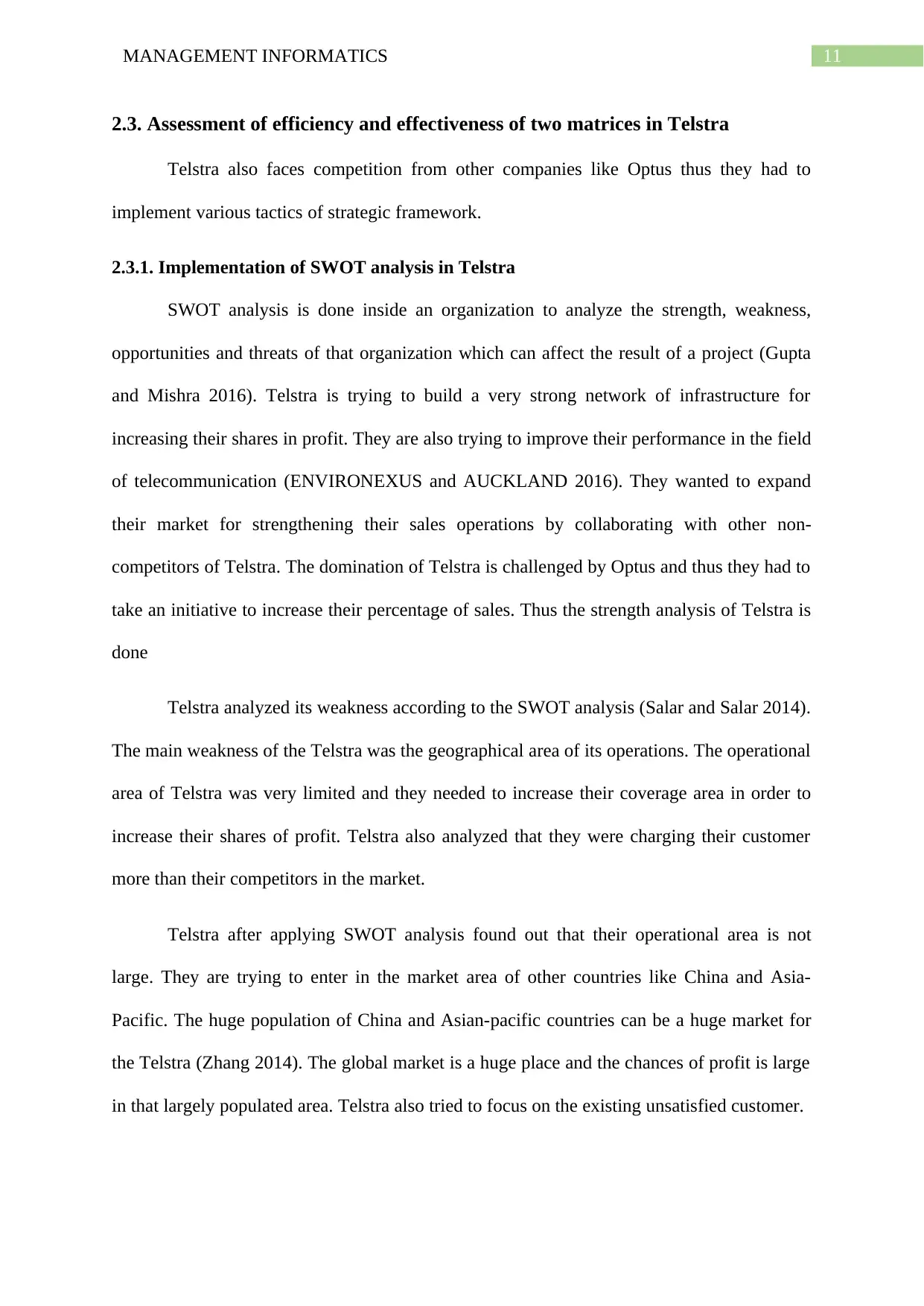
11MANAGEMENT INFORMATICS
2.3. Assessment of efficiency and effectiveness of two matrices in Telstra
Telstra also faces competition from other companies like Optus thus they had to
implement various tactics of strategic framework.
2.3.1. Implementation of SWOT analysis in Telstra
SWOT analysis is done inside an organization to analyze the strength, weakness,
opportunities and threats of that organization which can affect the result of a project (Gupta
and Mishra 2016). Telstra is trying to build a very strong network of infrastructure for
increasing their shares in profit. They are also trying to improve their performance in the field
of telecommunication (ENVIRONEXUS and AUCKLAND 2016). They wanted to expand
their market for strengthening their sales operations by collaborating with other non-
competitors of Telstra. The domination of Telstra is challenged by Optus and thus they had to
take an initiative to increase their percentage of sales. Thus the strength analysis of Telstra is
done
Telstra analyzed its weakness according to the SWOT analysis (Salar and Salar 2014).
The main weakness of the Telstra was the geographical area of its operations. The operational
area of Telstra was very limited and they needed to increase their coverage area in order to
increase their shares of profit. Telstra also analyzed that they were charging their customer
more than their competitors in the market.
Telstra after applying SWOT analysis found out that their operational area is not
large. They are trying to enter in the market area of other countries like China and Asia-
Pacific. The huge population of China and Asian-pacific countries can be a huge market for
the Telstra (Zhang 2014). The global market is a huge place and the chances of profit is large
in that largely populated area. Telstra also tried to focus on the existing unsatisfied customer.
2.3. Assessment of efficiency and effectiveness of two matrices in Telstra
Telstra also faces competition from other companies like Optus thus they had to
implement various tactics of strategic framework.
2.3.1. Implementation of SWOT analysis in Telstra
SWOT analysis is done inside an organization to analyze the strength, weakness,
opportunities and threats of that organization which can affect the result of a project (Gupta
and Mishra 2016). Telstra is trying to build a very strong network of infrastructure for
increasing their shares in profit. They are also trying to improve their performance in the field
of telecommunication (ENVIRONEXUS and AUCKLAND 2016). They wanted to expand
their market for strengthening their sales operations by collaborating with other non-
competitors of Telstra. The domination of Telstra is challenged by Optus and thus they had to
take an initiative to increase their percentage of sales. Thus the strength analysis of Telstra is
done
Telstra analyzed its weakness according to the SWOT analysis (Salar and Salar 2014).
The main weakness of the Telstra was the geographical area of its operations. The operational
area of Telstra was very limited and they needed to increase their coverage area in order to
increase their shares of profit. Telstra also analyzed that they were charging their customer
more than their competitors in the market.
Telstra after applying SWOT analysis found out that their operational area is not
large. They are trying to enter in the market area of other countries like China and Asia-
Pacific. The huge population of China and Asian-pacific countries can be a huge market for
the Telstra (Zhang 2014). The global market is a huge place and the chances of profit is large
in that largely populated area. Telstra also tried to focus on the existing unsatisfied customer.
⊘ This is a preview!⊘
Do you want full access?
Subscribe today to unlock all pages.

Trusted by 1+ million students worldwide
1 out of 21
Related Documents
Your All-in-One AI-Powered Toolkit for Academic Success.
+13062052269
info@desklib.com
Available 24*7 on WhatsApp / Email
![[object Object]](/_next/static/media/star-bottom.7253800d.svg)
Unlock your academic potential
Copyright © 2020–2025 A2Z Services. All Rights Reserved. Developed and managed by ZUCOL.


